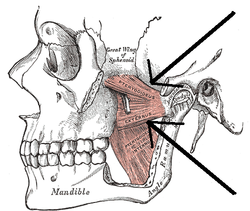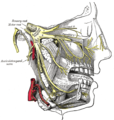|
Lateral pterygoid muscle
The lateral pterygoid muscle (or external pterygoid muscle) is a muscle of mastication. It has two heads. It lies superior to the medial pterygoid muscle. It is supplied by pterygoid branches of the maxillary artery, and the lateral pterygoid nerve (from the mandibular nerve, CN V3). It depresses and protrudes the mandible. When each muscle works independently, they can move the mandible side to side. StructureThe lateral pterygoid muscle has an upper head and a lower head.[1][2]
It lies superior to the medial pterygoid muscle. Blood supplyThe lateral pterygoid muscle is supplied by pterygoid branches of the maxillary artery.[citation needed] Nerve supplyThe lateral pterygoid muscle is supplied by the lateral pterygoid nerve, a branch of the mandibular nerve (CN V3), itself a branch of the trigeminal nerve (CN V). FunctionThe primary function of the lateral pterygoid muscle is to pull the head of the condyle out of the mandibular fossa along the articular eminence to protrude the mandible.[2] A concerted effort of the lateral pterygoid muscles helps in lowering the mandible and opening the jaw. Unilateral action of a lateral pterygoid muscle causes contralateral excursion (a form of mastication), usually performed in concert with the medial pterygoids.[citation needed] When they work independently, they can move the mandible side to side.[2] Unlike the other three muscles of mastication, the lateral pterygoid alone can assist in depressing the mandible (opening the jaw). At the beginning of this action it is assisted by the digastric, mylohyoid and geniohyoid muscles. Clinical significanceThe lateral pterygoid muscle may be involved in temporomandibular joint dysfunction.[1][2] Additional images
References
External links
|
||||||||||||||||||||||||||||||
Portal di Ensiklopedia Dunia





